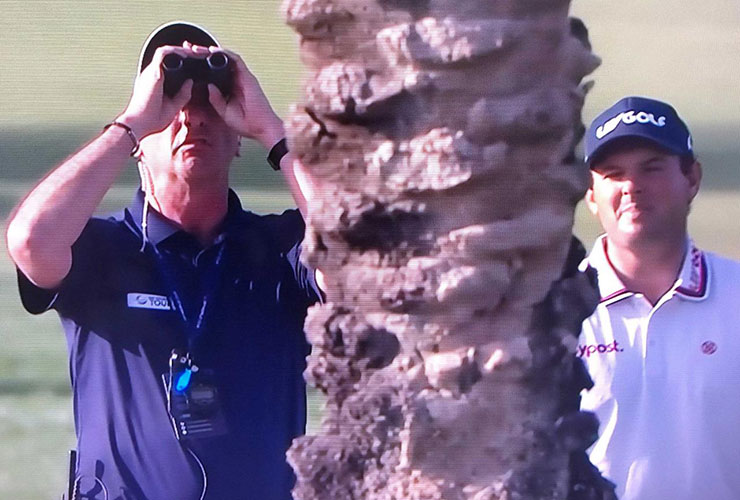Adding yet another entry to his list of brushes with the Rules of Golf — and another twist to an already chaotic week at the DP World Tour event — Patrick Reed found himself involved in what turned into an unusual discussion/decision when playing the 17th hole at the Emirates Club during the Sunday’s third round of the Hero Dubai Desert Classic.
Specifically, after hitting his drive on the par-4 17th hole, Reed’s ball became lodged high in a palm tree right of the fairway. Accompanied by the DP World Tour Chief Referee Kevin Feeney, the former Masters champion used binoculars to find what he said was his ball, insisting with 100 per cent certainty he was able to identify it in the tree per Rule 7.2. Given that information, Feeney allowed Reed to drop directly below the ball, taking a one-stroke penalty under the rule for an unplayable ball (Rule 19.2c). Reed subsequently made a bogey 5 on the hole.
“I got lucky that we were able to look through the binoculars,” said Reed at the end his round of 69 that left him on 11 under par and four shots back of the 54-hole leader Rory McIlroy. “You have to make sure it’s your ball. How I mark my golf balls is I always put an arrow on the end of my line, because (on) the Pro VI, the arrow on the end stops before it, so you can see the arrow. You could definitely see and identify the line with the arrow on the end. The rules official luckily was there to reconfirm and check it to make sure it was mine as well.”
Asked if he was “100 per cent” sure that it was his ball he had identified, Reed replied: “I would have gone back to the tee if I wasn’t 100 per cent.” Making things more difficult is that there were perhaps four or five other balls stuck in the same tree. Had he not been able to identify his ball, it would have been deemed lost and Reed would have had to return to the tee to play his third shot.
After seeing video of the shot, the question arose as to whether the tree Reed was looking at was actually the tree into which Reed’s ball appeared to be headed.

But, again, Reed insisted that with 100 per cent certainty he was able to identify his ball in the tree, and eventually the DP World Tour concurred, issuing a statement to confirm as much:
“During round three of the Hero Dubai Desert Classic, two on course referees and several marshals identified that Patrick Reed’s ball had become lodged in a specific tree following his tee shot on 17. The DP World Tour Chief Referee joined the player in the area and asked him to identify his distinctive ball markings. Using binoculars, the chief referee was satisfied that a ball with those markings was lodged in the tree. The player subsequently took an unplayable penalty drop (Rule 19.2c) at the point directly below the ball on the ground. To clarify, the player was not asked to specify the tree but to identify his distinctive ball markings to confirm it was his ball.”
Reed has been involved in rules issues in the past. In 2019, at the Hero World Challenge, Reed was penalised two strokes when PGA Tour rules officials determined he had violated Rule 8.1a (4) by moving sand during two practice swings over a shot he was playing from a waste bunker. And at the 2021 Farmers Insurance Open, there was a question about whether Reed should have been able to get relief from an embedded ball; PGA Tour rules officials subsequently said that Reed had acted within the Rules of Golf in that instance.
This week in Dubai had already been eventful for Reed, who plays on the LIV Golf circuit. Whether LIV golfers will be allowed to play in DP World Tour events in the future is the subject of a UK arbitration case that is schedule for early next month. Meanwhile, Reed caused a stir when he attempted to say hello to Rory McIlroy, an outspoken critic of LIV Golf, on the driving range on Tuesday. When it appeared that McIlroy rebuffed him, Reed tossed a tee toward McIlroy, a video of which eventually surfaced on the Internet. The “feud” between the two became the talk of the tournament before play finally began on Thursday.









